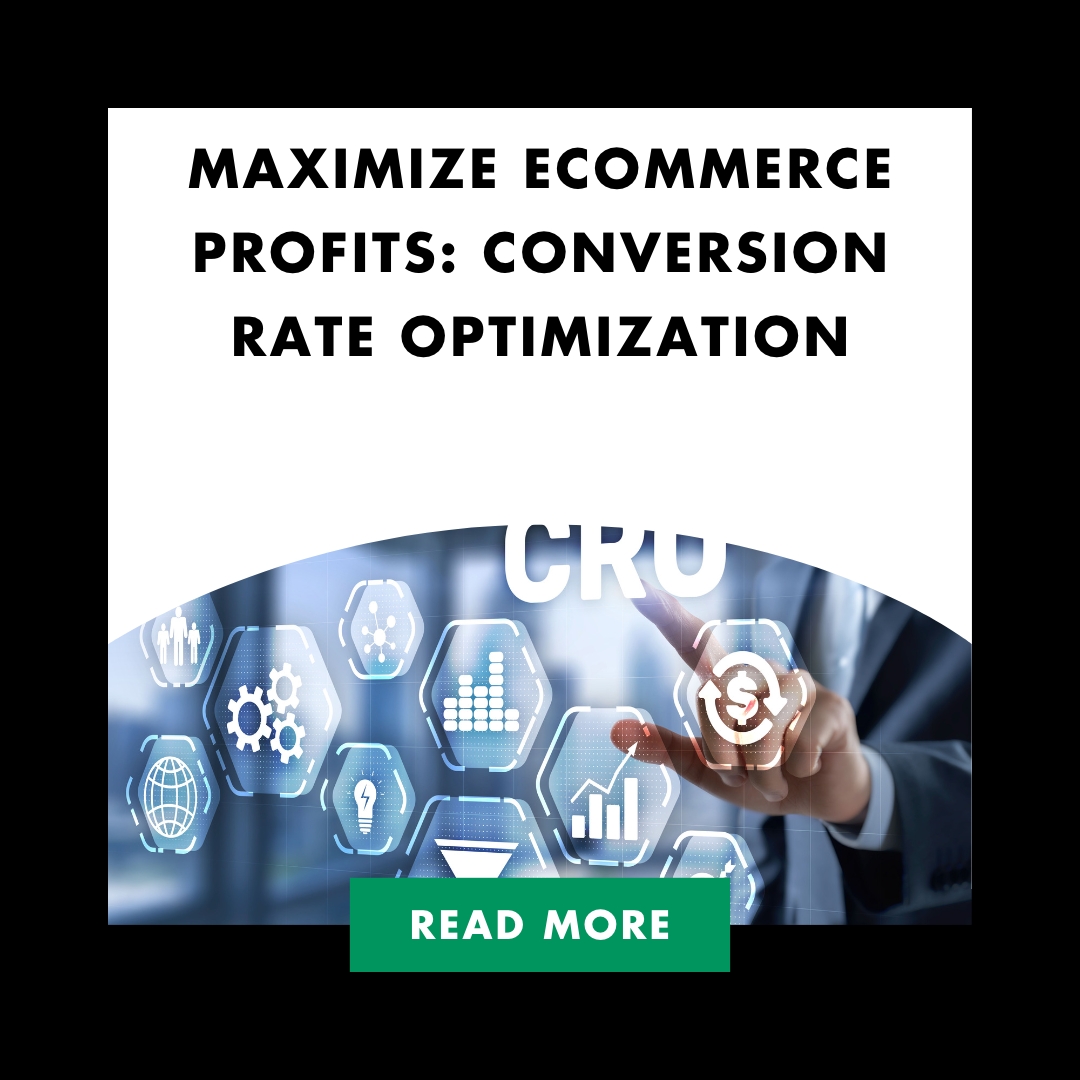Maximize eCommerce Profits: Conversion Rate Optimization
CRO is a must for any eCommerce venture, as it can boost profits by amplifying conversions and sales. In this blog post, we will dive deep into the intricacies of CRO and discuss various strategies to optimize your website’s conversion rates.
We’ll begin by understanding the importance of identifying conversion goals for each page and optimizing parts of your funnel receiving the greatest traffic. Next, we will explore how analyzing user experience plays a vital role in implementing effective CRO tactics.
Furthermore, you’ll discover top tools that can help you with eCommerce CRO analysis such as Optimizely’s visual editor for building multivariate tests without programming knowledge required; HotJar’s heatmap analysis feature; Quantcast Measure’s audience insights; and Google Analytics’ comprehensive data tracking.
Lastly, we will share five proven strategies to increase your eCommerce store’s online sales along with real-life examples of successful conversion rate optimization implementation from industry giants like Sony, Microsoft, Spreadshirt, and Smarter Travel.
Table of Contents
Understanding Conversion Rate Optimization
Identifying Conversion Goals for Each Web Page or App Screen
Optimizing Parts of Your Funnel Receiving Greatest Traffic
One of the most effective conversion rate optimization tools is to improve your website’s conversion rate. A good conversion rate is typically around 2-3%, but this can vary depending on your target audience and industry. By increasing conversions, you can generate more leads and potential customers, which can ultimately increase profits.
Calculating your site’s conversion rate is relatively simple. Divide the number of leads generated by the number of site visitors, and then multiply by 100. This will give you a percentage that represents your website’s conversion rate.
When it comes to increasing conversions, there are several strategies you can implement. For example, you can improve your website’s design and user experience, create more compelling calls-to-action, or offer incentives to encourage visitors to convert.
Ultimately, the key to successful conversion rate optimization is to understand your target audience and tailor your optimization efforts to their needs and preferences. By doing so, you can improve your conversion rate, increase revenue, and grow your business.
Grasping the significance of Conversion Rate Optimization is a key factor for any eCommerce enterprise, as it can assist in pinpointing areas to develop and enhance customer gratification. By analyzing user experience through surveys, A/B testing different variations and heat mapping to visualize user interactions, businesses are able to further optimize their conversion rates.
Analyzing User Experience for CRO
Surveys as a Tool to Gather User Feedback
Collecting user feedback via surveys can help you identify areas needing improvement and make informed decisions. This information can help you pinpoint specific issues and make data-driven decisions for improvements.
A/B Testing Different Variations
A/B testing involves creating two different versions of a web page or app screen and comparing their performance in terms of conversion rates. By analyzing the results, you can determine which version resonates better with your audience and implement changes accordingly.
Heat Mapping to Visualize User Interactions
Heat maps offer visual representations of how users interact with various elements on your site or app, such as clicks, scrolls, and mouse movements. Analyzing these interactions enables you to optimize design layouts and improve overall usability.
Analyzing user experience for CRO is an essential part of optimizing conversion rates and should be taken seriously. It is vital to comprehend the different utilities obtainable that can assist you in examining data more productively, for further augmenting your eCommerce business.
Top Tools for eCommerce CRO Analysis
If you don’t have an internal team dedicated to conversion rate optimization, agencies like Forest City Digital can help maximize revenues with specific optimization suggestions using tools such as Optimizely, HotJar, Quantcast Measure, and Google Analytics. Each tool offers unique features tailored towards analyzing ecommerce performance.
- Optimizely’s visual editor: This powerful tool allows you to build multivariate tests without any programming knowledge required. It helps in creating different variations of your website elements to test their effectiveness on user engagement and conversions. Learn more about how Optimizely works here.
- HotJar’s heatmap analysis feature: Heatmaps are a great way to visualize user interactions on your site or app by displaying the most clicked areas in color-coded format. HotJar provides this functionality along with other useful UX insights that can guide your CRO efforts. Check out HotJar’s capabilities here.
- Quantcast Measure’s audience insights: Understanding your audience is crucial for effective CRO implementation. Quantcast Measure offers detailed demographic data and behavioral patterns of users visiting your site which can be used for targeted optimizations leading to higher conversion rates. Explore more about Quantcast Measure here.
- Google Analytics’ comprehensive data tracking: This widely-used analytics platform tracks various metrics related to user behavior, traffic sources, bounce rates, and much more that can be utilized for informed decision-making in your CRO strategy. Learn how to leverage Google Analytics for eCommerce here.
Conversion rate optimization (CRO) is the process of improving a website’s conversion rate, which is the percentage of visitors who complete a desired action, such as making a purchase or filling out a form. A good conversion rate varies depending on the industry and the website’s conversion rate optimization process. However, the average conversion rate for ecommerce sites is around 2-3%.
To calculate conversion rate, divide the number of conversions by the number of visitors to your site and multiply by 100. For example, if your site had 10,000 visitors and 200 conversions, your conversion rate would be 2%.
Increasing conversions can lead to an increase in revenue and profits. To improve conversions, it’s important to understand your target audience and set a net revenue goal. You should also consider the average sales price and the number of leads generated ÷ potential customers. By optimizing your conversion funnel and focusing your optimization efforts on the areas that matter most, you can boost conversions and achieve your business goals.
Using the right tools for eCommerce CRO Analysis can help you gain a better understanding of your customer’s behavior and make more informed decisions. Now let’s explore five strategies to increase your online sales with an effective conversion rate optimization plan.
5 Strategies to Increase Your eCommerce Store's Online Sales
- High-quality images/videos on product pages: Using high-resolution images and engaging videos helps potential customers visualize products better, leading to increased conversion rates. Check out this guide on product photography tips for your online store.
- Installing SSL certificates at checkout process: Ensuring a secure shopping experience by installing an SSL certificate builds trust with customers and increases their likelihood of completing purchases. Learn more about the importance of SSL certificates in eCommerce websites here.
- Detailed product descriptions: Accurate, comprehensive and simple-to-understand product info assists shoppers in making educated choices while simultaneously enhancing SEO ratings. Read these tips on how to write effective product descriptions that sell.
- Valuable and functional content to boost organic traffic: Creating informative blog posts or guides related to your products not only drives organic traffic but also establishes you as an authority in your niche. Discover ways to create compelling content with this comprehensive guide on content marketing strategy.
- Live chat software for support and guidance: Offering real-time assistance through live chat enhances user experience by addressing queries promptly which can lead to increased conversions. Check out these top live chat software solutions for your eCommerce store.
By implementing these strategies, you can optimize your online store’s conversion rates and ultimately increase revenue and profits.
By implementing the strategies discussed above, you can increase your eCommerce store’s online sales and optimize customer experience. Real-life examples of successful CRO implementation provide further insights on how to achieve this goal effectively.
Real-life Examples of Successful CRO Implementation
Sony’s Website Redesign for Improved User Experience
Sony implemented a complete website redesign to improve user experience and increase conversions. By focusing on simplifying navigation, enhancing product pages with high-quality images, and optimizing calls-to-action, Sony saw a significant boost in online sales.
Microsoft’s A/B Testing Approach to Increase Conversions
Microsoft used A/B testing to experiment with different landing page designs and messaging. This data-driven approach helped them identify the most effective elements that led to higher conversion rates across their digital properties.
Spreadshirt’s Use of Heat Mapping Tools
Spreadshirt, a custom apparel company, utilized heat mapping tools like HotJar to analyze user behavior on their website. They identified areas where users were struggling or dropping off during the purchase process and made improvements accordingly – resulting in increased conversions.
Smarter Travel’s Content Marketing Strategy
Smarter Travel, a travel media company, implemented a content marketing strategy to drive organic traffic and improve conversion rates. By creating valuable, informative articles that supplemented their product offerings, they were able to engage users and increase sales.
FAQs in Relation to Conversion Rate Optimization
Optimization for conversion rate, or Conversion Rate Optimization (CRO), involves analyzing and improving the performance of a website or app to increase the percentage of visitors who complete desired actions, such as making purchases or signing up for newsletters. It includes testing various elements like design, content, and user experience to maximize conversions.
The most effective way to optimize conversions is by using data-driven strategies that involve analyzing user behavior, conducting A/B tests on different variations of your website elements, gathering feedback through surveys and heatmaps analysis. Implementing changes based on these insights can lead to improved user experience and higher conversion rates.
To learn CRO effectively, you can explore online resources like Coursera, Udemy, and blogs from industry experts such as Neil Patel. Additionally, attending webinars or conferences related to CRO will help you gain in-depth knowledge from professionals in this field.
Search Engine Optimization (SEO) focuses on increasing organic traffic by improving a website’s visibility in search engine results pages (SERPs). On the other hand, Conversion Rate Optimization (CRO) aims to increase the percentage of visitors who complete desired actions on a website or app. While SEO attracts users to your site, CRO ensures they engage and convert once they arrive.
Conclusion
In conclusion, conversion rate optimization is crucial for eCommerce business owners who want to increase online sales. By identifying conversion goals, analyzing user experience, utilizing top tools, and implementing effective strategies, businesses can improve their website’s performance and ultimately boost revenue.
At Forest City Digital, we specialize in helping businesses achieve their CRO goals through a variety of services, including website design and development, SEO optimization, and digital marketing. Let us help you reach your CRO goals and maximize website performance – contact us today!
Contact us to start driving more sales through your store with our CRO tactics!
Want to Talk Strategy?
Is this something you're looking to dive deeper into? Sign up for a free strategy session with our team!
Let's TalkSubscribe for New Content
Share on Social
New Posts to Check Out

Why We Build Content Around Funnel Stages, Not Keywords

SEO in 2025: How Staffing Firms and B2B Marketers Can Win



How to Get Verified for Google Local Service Ads: A Complete Guide

Revamping E-Commerce: AI Trends and Innovations in Design

How Do I Make An Ad For Local Search Google: A Practical Guide

How To Set Up Local Search Ads On Google: 2024 Guide
What is an LSA ad? Boost Your Local Service Visibility

